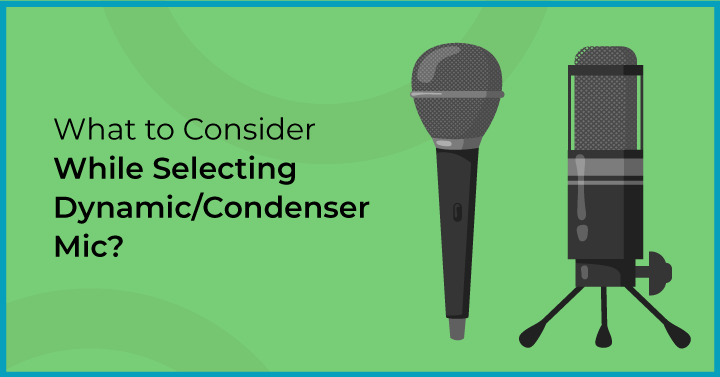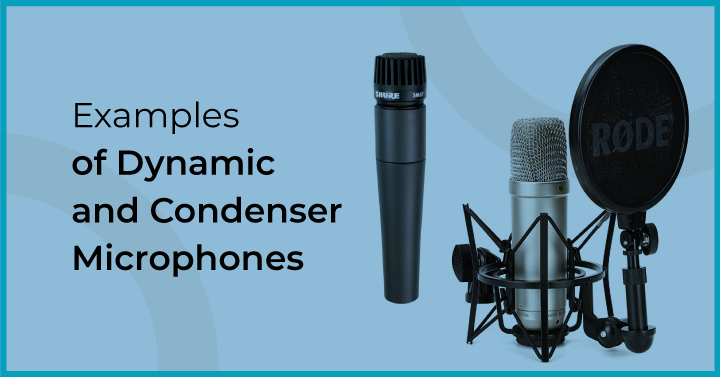
- What is a Microphone Diaphragm?
- What is a Dynamic Microphone?
- What is the Working Process for a Dynamic Microphone?
- Pros and Cons of Dynamic Microphonee
- What Is a Condenser Microphone?
- How Does the Condenser Microphone Work?
- Pros and Cons of Condenser Microphone
- What to Consider While Selecting Dynamic/Condenser Mic?
- Examples of Dynamic and Condenser Microphones
- FAQs
Should I get a condenser or dynamic microphone? If you’ve read the condenser vs. dynamic mic reddit discussions, you’ll know that wars (written ones at least) have been fought over this very question. And the truth is there’s no right or wrong answer. It all just comes down to what you’ll be using the equipment for as to which side of the condenser vs. dynamic microphone debate you come down on.
Here, we’ve broken down the most important considerations, as well as pros and cons related to each model.
1. What is a Microphone Diaphragm?
Before diving into the nitty-gritty of the condenser vs. dynamic microphone discussion, it’s important to understand one of the most important parts of every device: the diaphragm. The diaphragm consists of a thin membrane, usually made of either aluminum or Mylar plastic, which vibrates when hit by sound waves.
All microphone diaphragms change acoustic energy into electrical energy, but how they do this differs according to their design. There are three main categories of microphone diaphragm: moving coil, moving ribbon and condenser.
2. What is a Dynamic Microphone?
A dynamic microphone converts acoustic energy into electrical energy using electromagnetism. There are three key parts inside the mic that makes this happen: the diaphragm, the coil (or ribbon) and a magnet.
3. What is the Working Process for a Dynamic Microphone?
When sound waves hit the diaphragm, they vibrate the coil. This coil is within a magnetic field generated by the magnet. When the coil vibrates inside the magnetic field, it creates a current. (If you want to get technical, this is known as the induction principle.) The current is then carried along wires from the mic to an amplifier, mixing board or other audio device.
Instead of a moving coil, some microphones instead contain a ribbon. This ribbon functions in the same way as the coil, vibrating when hit by sound waves and generating a current due to the magnetic field.
4. Pros and Cons of Dynamic Microphone

4.1 Pros
1. Very Durable
Dynamic microphones tend to be hardier, meaning they are less likely to get damaged if you are carting them around. This is useful if you’re going on tour, for example.
2. You Can Simply Plug and Play
While you can get plug and play condenser mics as well, the simplicity of the dynamic mic makes it easier to hit the ground running.
3. Loud Recording System
Another aspect of the dynamic mic’s durability is that they aren’t as affected by loud instruments, such as drums.
4. No External Power is Required
Due to its passive design, the microphone itself requires no phantom power – or, indeed, any external power source – to function.
5. Cost Effective
Obviously, the price of your mic will depend on the brand, quality, etc. A general rule of thumb when comparing a condenser vs. dynamic microphone, however, is that the condenser will be more expensive.
6. Don’t Capture Background Noises
Dynamic mics are less sensitive to background noises, which is ideal for live performances with loud crowds.
7. Versatile
In general, dynamic mics can do a lot of things pretty well, such as band concerts, interviews or recording drums in a studio.
4.2 Cons
1. Not Suitable for High-Frequency Sounds
While they may excel at low frequency sounds like drums and bass guitar, dynamic microphones aren’t as good at capturing high frequency sounds like violins or certain vocals.
2. Less Sensitive
The number-one con of dynamic mics in the condenser vs. dynamic microphone is that they aren’t as sensitive to sound due to their heavier design.
5. What Is a Condenser Microphone?
A condenser microphones converts acoustic energy into electrical energy using electrostatics. There are two key parts inside the mic that make this happen: the movable diaphragm plate and the static backplate. An electrical current is required to give the plates a charge.
6. How Does the Condenser Microphone Work?
First, the mic has to have power, whether through a battery in the mic or a cable. When sound waves hit the condenser microphone, they cause the diaphragm to vibrate. This vibration changes the distance between the diaphragm plate and the backplate, creating an electrical change that is called a capacitance. The fluctuating voltage mimics the sounds being received.
7. Pros and Cons of Condenser Microphone

7.1 Pros
1. Excellent Sound Quality
The delicate construction of the condenser vs. dynamic microphone means it has very good sound quality, as it is more receptive to vibrations.
2. Higher Sensitivity
In general, the condenser mic’s ability to detect subtle vibrations means more nuanced sound across a wider range of frequencies. Of course, this can also be a negative attribute in some circumstances, as a condenser mic will pick up more unwanted ambient noise.
7.2 Cons
1. Self-noise
Self-noise refers to the sound made by the circuitry inside mics. Some condenser mics, particularly lower quality ones, are more prone to creating and then picking up these vibrations.
2. Requires External Power
One of the most notable downsides of a condenser vs. dynamic microphone is that it requires external power to charge the plates.
8. What to Consider While Selecting Dynamic/Condenser Mic?

8.1 Price
As with all things in life, the amount of money you have will necessarily dictate what microphone you purchase. There are many factors that can influence price, including brand, design and general buying trends. If you’re on a budget, good dynamic mics tend to be cheaper than good condenser mics, but that certainly isn’t always the case, so make sure to shop around.
8.2 The Frequency Response
Whether the sound you intend to record is of a higher or lower frequency will dictate the kind of mic you buy. In general, dynamic mics are better for mid or lower frequency sounds, while condensers capture a broader frequency range.
8.3 Recording Environment
Recording environment is another hugely important aspect to consider. If you are debating between a condenser vs dynamic mic for streaming video game play, for example, a dynamic mic is probably the more suitable option. Most gamers record from their homes, and a condenser mic will pick up too much of the background noise that inevitably comes with a habitation. If you’re in a professional studio recording a podcast, on the other hand, the booth is probably well soundproofed. In this scenario, you’d probably opt for the condenser vs dynamic mic for podcasting, as the condenser will give you better sound quality.
8.4 Polar Patterns
Polar patterns are the spaces around a microphone that pick up sound. There are three main types of polar pattern for both dynamic and condenser mics:
- Cardioid mics are named because they loosely resemble a heart shape. They generally are more sensitive to sound coming from the front, while reducing noises from the sides and rear. Cardioid is the most commonly seen polar pattern because it can be used for everything from podcasting and streaming to recording vocals for songs. There are variations of this pattern called super-cardioid and hyper-cardioid, which are simply even more tightly focused versions of the classic cardioid.
- Omnidirectional mics pick up sound coming from all sides. They are used for situations such as recording a play, when people are speaking from different places on the stage.
- Bidirectional mics focus on sounds in the front and the rear, while blocking noise from the sides. Due to the shape of the reception area, this polar pattern is also known as a figure of 8. You might use this mic when you are conducting an interview and facing the other person.
9. Examples of Dynamic and Condenser Microphones

9.1 Shure SM57
The Shure SM57 is a dynamic microphone that has been a staple in the recording industry for over five decades. Its durable design, versatility, and ability to handle high sound pressure levels make it a popular choice for musicians, engineers, and producers. It is known for its ability to capture the nuances of acoustic instruments, as well as the punch and power of drums and electric guitars. It is a popular choice for podcast recordings and continues to be a trusted tool for capturing high-quality sound in both studio and live settings.
- Price: $99
- Type: Dynamic
- Polar pattern: Cardioid
- Frequency response: 40 to 15,000 Hertz
9.2 Rode NT1-A
The Rode NT1-A is a high-quality, large diaphragm condenser microphone that has become a popular choice for recording vocals, acoustic guitars, and other instruments. Its smooth, warm sound and low noise floor make it a favourite among professional musicians and sound engineers. Its durable design and included shock mount make it easy to use and a reliable tool for studio recording.
- Price: $199
- Type: Condenser
- Polar pattern: Cardioid
- Frequency response: 20 to 25,000 Hertz
9.3 Sennheiser MD 421-II
The Sennheiser MD 421-II is a dynamic microphone with a rugged design and versatile sound, making it a go-to choice for recording drums, electric guitars, and vocals. It features a cardioid polar pattern, which ensures focused sound capture from the front while rejecting sound from the sides and rear. With an excellent frequency response and high SPL handling, it is an ideal choice for capturing the power and dynamics of loud sound sources.
- Price: $399.95
- Type: Dynamic
- Polar pattern: Cardioid
- Frequency response: 30 to 17,000 Hertz
9.4 Neuman TLM 103-MT
The Neumann TLM 103 is a large diaphragm condenser microphone known for its clarity, warmth, and versatility. Its cardioid polar pattern ensures focused sound capture from the front, while its low self-noise and high SPL handling make it a popular choice for recording a wide range of instruments and vocals. The TLM 103 features a fixed capsule with a frequency response that has been tailored to accentuate the mid and high-frequency ranges, resulting in a smooth and detailed sound.
- Price: $1,195
- Type: Condenser
- Polar pattern: Cardioid
- Frequency response: 20 to 20,000 Hertz
9.5 Electro-Voice RE20
The Electro-Voice RE20 is a badass dynamic microphone that is a top choice for recording vocals, instruments, and podcasts. It’s got a cardioid polar pattern, which means it captures sound from the front and rejects sound from the sides and rear. It’s got a sleek design and delivers awesome sound quality, making it a go-to mic for professionals in broadcasting and music.
- Price: $445.98
- Type: Dynamic
- Polar pattern: Cardioid
- Frequency response: 45 to 18,000 Hertz
9.6 Stellar X2
The Stellar X2 microphone is a condenser mic that’s getting a lot of buzz these days. It’s got a large diaphragm and a cardioid polar pattern to capture sound from multiple directions. It delivers a warm and detailed sound making it a great choice for recording vocals, acoustic guitars, and other instruments. Plus, it’s got a low self-noise and high SPL handling, so you can crank it up without worrying about distortion or background noise.
- Price: $199.99
- Type: Condenser
- Polar pattern: Cardioid
- Frequency response: 20 to 18,000 Hertz
10. FAQs
- Do Dynamic Microphones Require Power?
Dynamic microphones do not require power. This is because they do not contain active circuitry, only passive electronics.
- Which Is Better: Condenser or Dynamic Mic?
It depends on your purpose and your recording environment as to whether you opt for a condenser vs. dynamic microphone. In general. If you want a more sensitive mic that picks up all sounds, then a condenser mic is better. Most podcasters, however, use a dynamic mic because they record from home, and a dynamic mic will pick up their voice while ignoring ambient noise.
- What are Condenser Microphones Best for?
Condenser microphones are best for situations where you want a more nuanced sound and a greater breadth of frequency. For example, they are ideal for recording vocals in a professional studio where no background noise will be audible.



